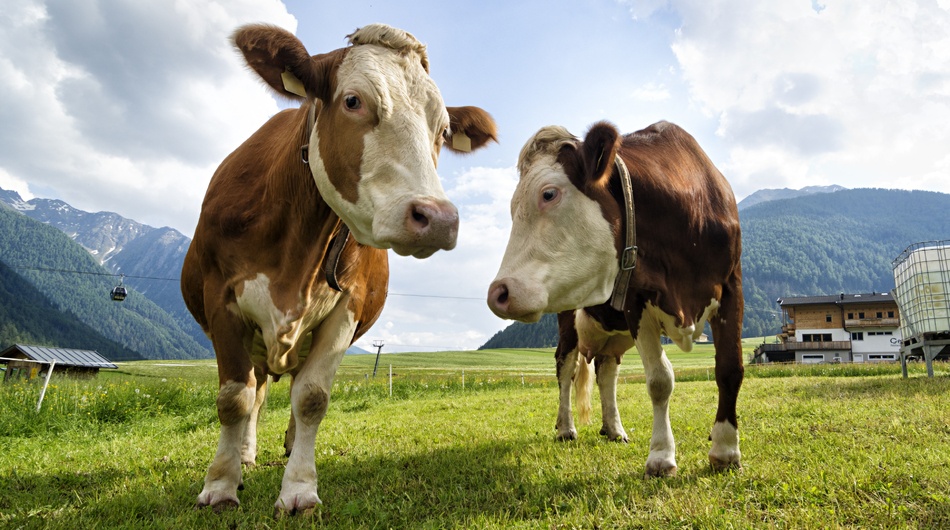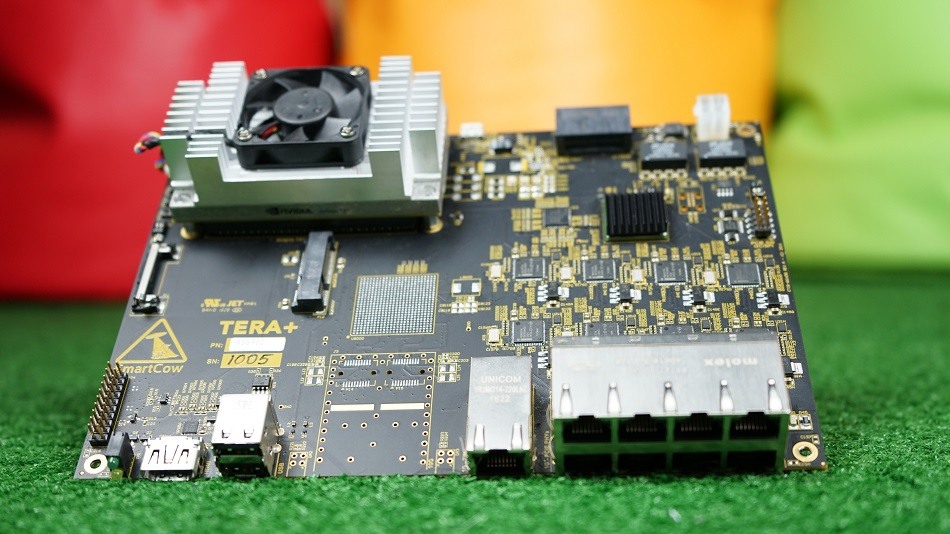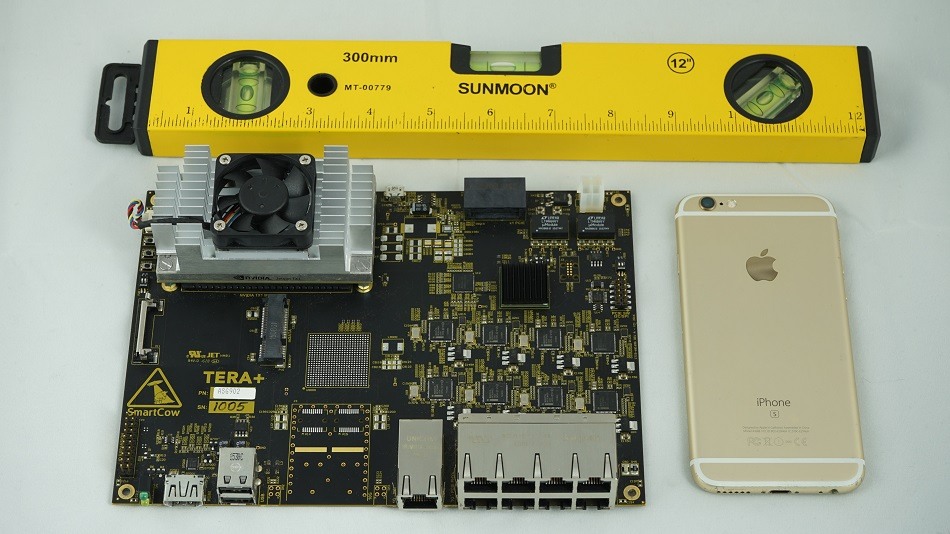
A couple of not so smart cows. Photo credit: mnyjhee / 123RF.
When the Raspberry Pi came out in 2012, it gave tech enthusiasts an affordable, powerful, and customizable piece of hardware to build all kinds of cool stuff with, like the PiPhone and Erica the Rhino.
Annabelle Kwok knows that mindset well, herself a dedicated maker-tinkerer. So she wanted to apply it to a more demanding challenge: artificial intelligence. That’s why she built what she envisions as the “Raspberry Pi for AI.”
This is not the device’s actual name, which is too bad because it rhymes so well. But it’s definitely the intent behind its creation: a low-cost, powerful computing device that can take on complex processes like computer vision and deep learning. The hardware, made by Kwok’s startup, Smartcow, is actually called Tera.
Right now, computer vision and deep learning applications usually rely on cloud computing, Kwok says. The idea is, you send your data to a server operator somewhere, like AWS, computations are made, results come back. That’s costly and, for all the security features cloud services promise, it means you don’t have complete control of your data. Local server infrastructure, meanwhile, is expensive to set up and maintain.
Her approach to the problem is edge computing, an alternative to cloud computing that places processing equipment near the location where the data is gathered. For example, a camera in a retail store will relay data to be processed on a device nearby, rather than beam it to a data center somewhere else.
Tera serves this exact purpose: to be a device that’s easy to set up and use but powerful enough to process and store oodles of data.

The Tera+ board by Smartcow. Photo credit: Smartcow.
Juggling different roles
Singapore-based Smartcow has an office at SGInnovate’s space, which is where I meet Kwok. The first thing I notice during our conversation is her enthusiasm, which almost takes me aback.
At 24, Kwok clearly takes pride in what she and her co-founder, Ravi Kiran, have created, and isn’t afraid to let it show. It’s the kind of pride that seems to stem from the conviction they’re working on something really cool.
Kwok is a math graduate from Singapore’s Nanyang Technological University. She finished her courses in three years instead of the required four, one of only four or five students in her school to do so. “I would cram my modules together so that I would graduate faster,” she says.
It powered thermal cameras in the sewers of Singapore to study rat movements.
But she hadn’t applied for an accelerated three-and-a-half-year course so she couldn’t graduate early. That left her with a lot of free time and no university degree with which to look for a job in the meantime.
That’s when she started buying Arduino boards. “Online shopping is my guilty pleasure,” she admits. Having taken some computing classes and an interest in tinkering, she started joining hackathons and maker fairs.
She won the grand prize at IOT Hackathon 2015, organized by Singapore’s Agency for Science, Technology, and Research (A-STAR), for a smart shoe insole that analyzes how your foot makes contact with the ground, to enable healthier movement. She’s also built things like self-stabilizing robots and GPS tracking devices.
Kwok immersed herself in the maker community through these hackathons, even if it led to her attending a few too many of them (“I think the organizers didn’t want to see my face anymore”). The contacts she made led to TV projects with National Geographic and WWF, where she had the chance to learn from industry professionals.
“That’s when you move from enthusiastic hobbyist to someone who is taking it more seriously,” she says.
Even though she had never put together a CV, Kwok says offers started coming from as high up as A-STAR and Microsoft. But the corporate environment didn’t appeal to her. Instead, she spent some time at Garena (now Sea) doing community management for online marketplace Shoppee. Then she left to join the circus.
“I can legit spin plates,” she insists, seeing the disbelief on my face.
She juggled for a few months before she started Smartcow. “I kind of wanted a break from it all,” is her explanation.

Smartcow co-founders Annabelle Kwok and Ravi Kiran. Photo credit: Smartcow.
On board
Tera and the startup were born when she was trying some computer vision applications and her computer couldn’t handle them. Doing some research, she realized there wasn’t an easily accessible device to do what she wanted. So she decided to build one.
Tera is a circuit board with ports to accommodate up to eight industrial-use cameras or other internet-connected equipment, 1 TB of memory, and the Nvidia Jetson TX1 chip (with support for its successor, the TX2). Kwok says Tera computes at 1 to 1.5 teraflops per second, with a power input of 12 volts, 5 amperes.
Nvidia’s Jetson chips are a big part of the puzzle – compact computer systems specially designed as development tools to enable edge computing. Smartcow has used the system to set up Tera’s different ports that can work together or separately, making sure all the different drivers play nice with each other.
Figuring out the processor like that makes what the startup does harder to copy, Kwok says. Smartcow uses Nvidia’s TensorRuntime Engine, on top of which it’s built its own software development kit. Making it all work took “a lot of blood, sweat, and, maybe not tears but a lot of hair pulling – I have thinning hair now,” she quips.
Much like the Pi, multiple Teras can be stacked, or daisy-chained, to boost capability – basically creating a little server rack that can handle more intensive tasks.
The device is plug-and-play, which means the user only has to connect it to the desired equipment and fire it up. Smartcow includes pre-installed software that allows for a variety of applications and doesn’t require a lot of coding know-how to get going. The startup is working to simplify the software even more, so that no coding will be needed.
The hardware addresses several industrial use cases, which is the main market Smartcow is targeting. The startup complements its hardware business with software development and consultancy, offering end-to-end solutions.
Kwok hopes to bring down Tera’s price as the startup ramps up manufacturing.
Some problems it has been called up to solve include placing thermal cameras in the sewers of a Singapore residential area to study rat movement during an infestation. The system had to be trained with rat images to be able to follow them more accurately. “I had to look at a hundred thousand images of rats,” Kwok says. “At least they were thermal images!”
Another application is a collaboration with a German company to do blood testing for malaria in rural Philippines. The process traditionally involves people hiking to villages to collect blood samples and taking them back to a lab for analysis – a time-consuming process that limits the number of samples they can transport and analyze.
Using Tera, they can set up mobile analysis labs to speed up the process. The device’s ability to work offline, extendable processing power, low power consumption, and small form factor contribute to its attractiveness.
Companies have also approached the startup to use the device for industrial automation, like automatic inspection of printed circuit boards, which requires processing a lot of images showing tiny components. Another use is retail insights, like being able to track customers’ movements and interactions with items within a store.
A retailer can even connect their point-of-sale system to the device and do their own data analytics and security within their store. With its retail solution, Smartcow won a competition by Nvidia Inception, an accelerator for AI solutions that incubated the startup.
The lower cost – around US$1,800 per unit – and reduced power consumption makes Tera a more attractive proposition for companies who want to run their own infrastructure.

One of Tera’s advantages is its small form factor. Photo credit: Smartcow.
AI for the people
Smartcow has raised angel funding “in the six figures” so far and is in the process of launching its pre-series A round. In the meantime, it’s setting up projects with new clients and working on new hardware and software products, which the team will reveal down the line. Its goal is to combine AI hardware and software services.
While the offerings are business-focused at the moment, Kwok hopes to eventually bring the price down as the startup scales up manufacturing, to make it accessible to consumers. Manufacturing takes place overseas, but the startup is looking for ways to bring the process to Singapore.
“It would be my personal goal to see it go to consumer level because that was how I started out,” Kwok says. She’s a big proponent of the idea that everyone needs to learn how to code and hopes Tera can enable the makers and tinkerers of the AI age. “I want this to be there for people doing deep learning but don’t have hardware to test [their knowledge] on,” she adds.
That’s good news, as the maker community is definitely getting more involved in AI. The Raspberry Pi itself is getting a hardware upgrade in collaboration with Google, which should enable it to process voice commands with Google Assistant. It’s part of a project called AIY, or “artificial intelligence yourself.”
Singapore, in the meantime, is leaning hard into AI research and development, with an investment of US$107 million over the next five years. The initiative, called AI.SG, aims to promote both AI-related projects as well as boost education and training in the sector.
As for that name? The startup offers various theories for it on its “About” page. That said, Kwok, who’s also musically trained, dreams of one day playing music in front of cows. Kiran, on the other hand, thinks they’re quite tasty.
This post She’s made a Raspberry Pi for AI in Singapore appeared first on Tech in Asia.
from Tech in Asia https://www.techinasia.com/raspberry-pi-for-ai-startup-smartcow
via IFTTT
No comments:
Post a Comment